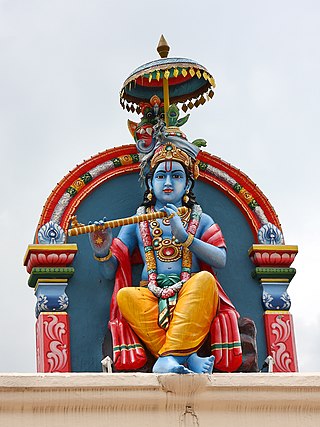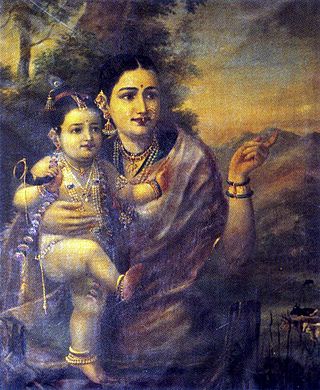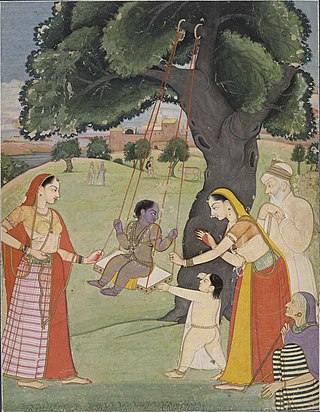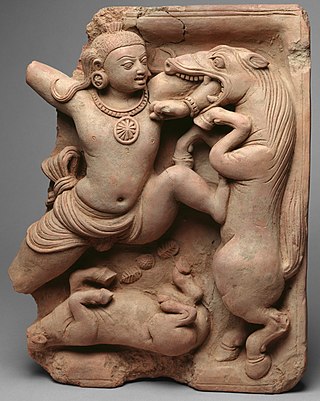
Krishna is a major deity in Hinduism. He is worshipped as the eighth avatar of Vishnu and also as the Supreme God in his own right. He is the god of protection, compassion, tenderness, and love; and is widely revered among Hindu divinities. Krishna's birthday is celebrated every year by Hindus on Krishna Janmashtami according to the lunisolar Hindu calendar, which falls in late August or early September of the Gregorian calendar.

Balarama is a Hindu god, and the elder brother of Krishna. He is particularly significant in the Jagannath tradition, as one of the triad deities. He is also known as Haladhara, Halayudha, Baladeva, Balabhadra, and Sankarshana.

Devaki is a character in Hindu literature, most noted for being the mother of the god Krishna. She is one of the seven daughters of Devapa or Devaka, a king of the Yadu dynasty, and has four brothers. She is one of the wives of Vasudeva. Her cousin is Kamsa, the king of Mathura, a cruel tyrant who had been told by Narada that he had been an asura killed by Vishnu in his previous life (Kalanemi), exacerbating his wickedness. According to popular tradition, Devaki is considered to be an incarnation of Aditi, a mother goddess who was the daughter of Daksha and the wife of Kashyapa.

Vasudeva, also called Anakadundubhi, is the father of the Hindu deities Krishna, Balarama, and Subhadra. He was a king of the Vrishnis. The son of the Yadava king Shurasena, he was also the second cousin of Nanda, the foster-father of Krishna. His sister Kunti was married to Pandu.

Yashoda is the foster-mother of Krishna and the wife of Nanda. She is described in the Puranic texts of Hinduism as the wife of Nanda, the chieftain of Gokulam, and the sister of Rohini. According to the Bhagavata Purana, Krishna was born to Devaki, but Krishna's father, Vasudeva, brought the newborn Krishna to his cousin Nanda, and his wife, Yashoda, in Gokulam. This was for his upbringing, as well as to protect Krishna from Devaki's brother, Kamsa, the tyrannical king of Mathura.

Krishna Janmashtami, also known simply as Krishnashtami, Janmashtami, or Gokulashtami, is an annual Hindu festival that celebrates the birth of Krishna, the eighth avatar of Vishnu. In certain Hindu texts, such as the Gita Govinda, Krishna has been identified as supreme God and the source of all avatars. Krishna's birth is celebrated and observed on the eighth day (Ashtami) of the dark fortnight in Shravana Masa. According to the purnimanta tradition), Krishna's birth is celebrated on the eighth day (Ashtami) of the dark fortnight in Bhadrapada Masa.

Pradyumna is the eldest son of the Hindu deities Krishna and his chief consort, Rukmini. He is considered to be one of the four vyuha avatars of Vishnu. According to the Bhagavata Purana, Pradyumna was the reincarnation of Kamadeva, the god of love. The Mahabharata states that Pradyumna was a portion of Sanat Kumara.

The Bhagavata tradition, also called Bhagavatism, is an ancient religious sect that traced its origin to the region of Mathura. After its syncretism with the Brahmanical tradition of Vishnu, Bhagavatism became a pan-Indian tradition by the second century BCE, according to R.C. Majumdar.

Nanda is a cow-herd chief, and the foster-father of Krishna, featured in the Harivamsha and the Puranas. Nanda is the son of Parjanya, a ruler of the Vraja region, who is a son of the Yadava king, Devamidha. He is the chief of Gokulam, which is one of the most powerful territories of the Yadava tribe. He is sometimes referred to as a king.

In Hindu mythology, Rohini is the first consort of Vasudeva, the sister of Yashoda, and the mother of the Hindu deities Balarama and Subhadra. She plays a prominent role in the upbringing of Krishna.

The Yadava were an ancient Indian people who believed to be descended from Yadu, a legendary king of Chandravamsha lineage.

Kamsa was the tyrant ruler of the Vrishni kingdom, with its capital at Mathura. He is variously described in Hindu literature as either a human or an asura; The Puranas describe him as an asura, while the Harivamśa describes him as an asura reborn in the body of a man. His royal house was called Bhoja; thus, another of his names was Bhojapati. He was the cousin of Devaki, the mother of the deity Krishna; Krishna ultimately fulfilled a prophecy by slaying Kamsa.

Ugrasena is a character mentioned in the Hindu epic, Mahabharata. He is the King of Mathura, a kingdom that was established by the Vrishni tribes from the Yadavamsha clan. His son Kamsa was a cousin of Krishna's mother, Devaki. King Ugrasena was overthrown by Kamsa, and was sentenced to life in prison, along with Kamsa's cousin, Devaki, and her husband, Vasudeva. Krishna reinstalled Ugrasena as the ruler of Mathura once more after defeating his wicked uncle.
Harivaṃśapurāṇa was composed by Acharya Jinasena I in 783 AD. It is divided into 66 cantos and contains 12,000 slokas. The book aims to narrate the life of Neminatha, the twenty-second Tirthankara in Jainism. According to the Jain sources, Krishna was the first cousin of Tirthankara Neminatha. Therefore, Krishna's adventures too occupy a significant portion of the book. Harivaṃśa Purāṇa suggests that Draupadi was married to only Arjuna, as opposed to Hindu traditional accounts which suggests that she was married to all the five Pandavas.

Krishnaism is a term used in scholarly circles to describe large group of independent Hindu traditions—sampradayas related to Vaishnavism—that center on the devotion to Krishna as Svayam Bhagavan, Ishvara, Para Brahman, who is the source of all reality, not simply an avatar of Vishnu. This is its difference from such Vaishnavite groupings as Sri Vaishnavism, Sadh Vaishnavism, Ramaism, Radhaism, Sitaism etc. There is also a personal Krishnaism, that is devotion to Krishna outside of any tradition and community, as in the case of the saint-poet Meera Bai. Leading scholars do not define Krishnaism as a suborder or offshoot of Vaishnavism, considering it at least a parallel and no less ancient current of Hinduism.
Svayam Bhagavan is a Sanskrit concept in Hinduism, referring to the absolute representation of Bhagavan as the Supreme God in a monotheistic framework. The concept is most commonly associated with a male deity, for instance in Hindu sub-movements like Krishnaism and Gaudiya Vaishnavism, in which Krishna is regarded as Svayam Bhagavan.

Akrura is a Yadava prince in Hinduism, best known for being the uncle of the deity Krishna. The son of Śvaphalka and Gandini, a daughter of the king of Kashi, he is instructed by Kamsa to drive his nephews, Krishna and Balarama, to a Dhanuryāga at Mathura, where they were to be slain. He bears witness to the vishvarupa (theophany) of Krishna during this journey. Akrura becomes the owner of the Syamantaka jewel after the death of its previous owner, Satrajit. He is slain during the internecine Yadu massacre at Prabhasa.

In Hindu mythology, Keshin, also called Keshi is a horse-demon, killed by Krishna, an Avatara of Vishnu. The demon was dispatched by Krishna's evil uncle Kamsa, who was destined to die at Krishna's hands.

Ekanamsha is a Hindu goddess. She is primarily identified with the illusory power of Vishnu as Yogamaya.

Yogamaya is a Hindu goddess who serves as the personification of Vishnu's powers of illusion. In Vaishnava tradition, she is accorded the epithet Narayani—"the sister of Narayana (Vishnu)"—and is regarded as the benevolent aspect of the goddess Durga.

























